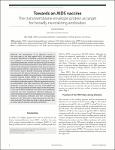Towards an AIDS vaccine: The transmembrane envelope protein as target for broadly neutralizing antibodies
Denner, Joachim
Although the development of an effective vaccine is the main goal in the fight against AIDS, all attempts by numerous laboratories to develop a vaccine have failed so far. In addition, it is still unclear whether cytotoxic T cells or neutralizing antibodies or both should be induced. The major advantage of neutralizing antibodies is their ability to prevent infection and subsequent integration of the provirus into the cellular genome where it may persist in a form invisible to the immune system. Broadly neutralizing antibodies have been found in HIV infected individuals, including antibodies directed against a highly conserved region in the membrane proximal external region (MPER) of the transmembrane envelope (TM) protein gp41 of HIV-1. We successfully induced neutralizing antibodies against different gammaretroviruses by immunization with their respective TM proteins. These antibodies recognized epitopes not only in the MPER but also in the fusion peptide proximal region of the TM protein. In the case of feline leukaemia virus (FeLV), these antibodies protected cats from antigenemia following challenge. To understand the mechanism of neutralization, the interactions between neutralizing antibodies and their corresponding epitopes in the TM protein of gammaretroviruses and HIV-1 were analysed. These data may help to design antigens able to induce specific broadly neutralizing antibodies.
No license information
Related Items
Show related Items with similar Title, Author, Creator or Subject.
-
2010-05-24ZeitschriftenartikelInducible costimulator (ICOS) blockade inhibits accumulation of polyfunctional T helper 1/T helper 17 cells and mitigates autoimmune arthritis Frey, Oliver; Meisel, Juliane; Hutloff, Andreas; Bonhagen, Kerstin; Bruns, Lisa; Kroczek, Richard; Morawietz, Lars; Kamradt, ThomasObjectives: Inducible costimulator (ICOS) and its ligand (ICOSL) regulate T and B cell responses. Glucose-6-phosphate isomerase (G6PI)-induced arthritis requires T and B lymphocytes. It was hypothesised that blocking ...
-
2016-02-26ZeitschriftenartikelLocal T/B cooperation in inflamed tissues is supported by T follicular helper-like cells Van, Dana Vu; Beier, Katja C.; Pietzke, Lea-Jean; Baz, Maysun S. Al; Feist, Randi K.; Gurka, Stephanie; Hamelmann, Eckard; Kroczek, Richard; Hutloff, AndreasAutoimmune diseases and other inflammatory conditions are characterized by large lymphocytic tissue infiltrates in which T and B cells can be found in close contact. Here, using a murine airway inflammation model, we compare ...
-
2013-04-15ZeitschriftenartikelGiardia duodenalis arginine deiminase modulates the phenotype and cytokine secretion of human dendritic cells by depletion of arginine and formation of ammonia Banik, Stefanie; Viveros, Pablo Renner; Seeber, Frank; Klotz, Christian; Ignatius, Ralf; Aebischer, ToniDepletion of arginine is a recognized strategy that pathogens use to evade immune effector mechanisms. Depletion depends on microbial enzymes such as arginases, which are considered virulence factors. The effect is mostly ...

